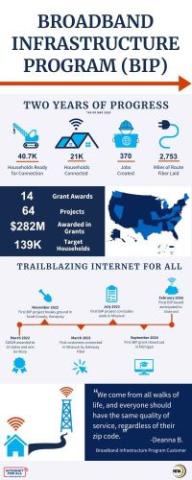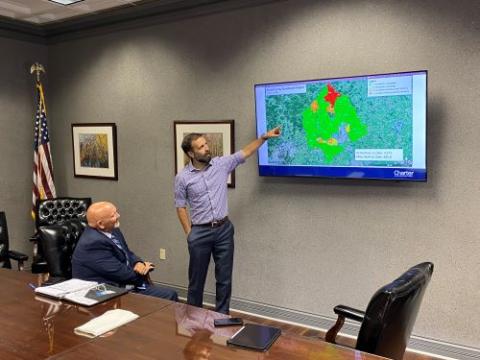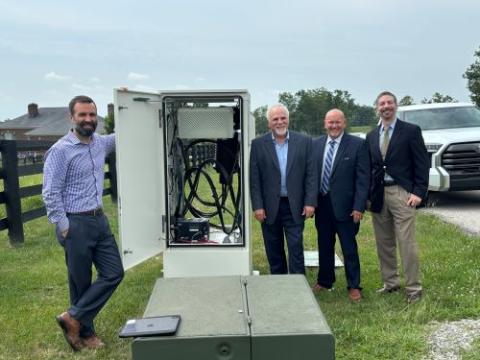Just over two years ago, NTIA launched the Broadband Infrastructure Program, or BIP, to bridge the connectivity gap in unserved communities, including rural communities, in America. As the first grant program to launch under the Biden-Harris Administration’s Internet For All (IFA) Initiative, BIP has been leading the way with NTIA’s historic investment in broadband infrastructure, serving as a roadmap for other connectivity projects to follow.
Progress to Date
In 2022, through a competitive process, NTIA awarded a collective $282.7 million to 13 states and one territory to expand broadband infrastructure. Since then, BIP awardees have made high-speed Internet service available to more than 40,000 previously unserved households, nearly 3,000 businesses, and more than 130 community anchor institutions (like schools and libraries) to date. Additionally, they have constructed or upgraded more than 2,750 miles of fiber.
The graphic below summarizes a brief timeline of notable BIP milestones:

NTIA works closely with grantees to keep these projects on track. One such example is the Scott County Fiscal Court in Kentucky, who has been rapidly expanding high-speed Internet access across underserved regions in rural parts of the commonwealth.
Success Story: Scott County, Kentucky
Scott County is located in central Kentucky in the Lexington metro area. While other counties in the area are relatively well-connected, Scott County has historically lagged behind. In the wake of the COVID-19 pandemic, a county-wide survey showed that many addresses in the county were unserved by any Internet service provider. Residents struggled with remote learning, from children trying to attend homeschool lessons to people trying to pursue secondary learning opportunities online. Additionally, the country’s unemployment rate skyrocketed from 3.5 percent in August 2019 to 5.9 percent in August 2020.
Scott County and their partnered Internet service provider, Spectrum, began to work in tandem through a $3.1 million NTIA BIP grant to accelerate Scott County’s post-COVID-19 economic recovery while repairing decades of digital inequity. Their goal was to support both remote working and learning. They wanted to provide residents that were digitally isolated with opportunities to participate in online entrepreneurship and the gig economy. They also wanted to be able to support residents applying for jobs online and connecting with opportunities through professional networking platforms.
First BIP Project to Break Ground
Scott County was the first BIP grant recipient to break ground on their project, having since built out 486 miles of fiber at time of this publication. NTIA has worked closely with Scott County by providing various forms of technical assistance, including over 48 touch-point calls with program leadership, as well as monthly opportunities to participate in informative webinars and office hours. These different avenues of technical assistance helped provide Scott County Fiscal Court with the tools they needed to build their office’s capacity from the ground up while also complying with federal regulations and requirements.
Scott County Fiscal Court is making rapid progress towards their goal to connect approximately 5,351 unserved homes. As of July 2024, they have served 4,572 unserved households in their project area. In addition to households, the project is designed to include 12 community anchor institutions, two elementary schools, 273 registered businesses, and 52 farms. They continue to work closely with Spectrum to collectively expedite their roll-out and ensure residents have access to high-speed Internet speeds up to 1/1 Gbps.

Joe Pat Covington, Scott County Judge and Executive, said of the BIP project:
“This has been a great project for Scott County. The collaborative efforts of the NTIA and their staff have made the process efficient and well managed. We have hit a grand slam for our community,” Covington said. “I am proud of the vision of the Fiscal Court and its commitment to our broadband project. Fiber to the home broadband connectivity will assure that our entire community has the ability to take advantage of online education, home-based business, and tele-health opportunities. Broadband will help with the continued growth of economic opportunities for all our citizens.”
“We are very thankful to Assistant Secretary of Commerce for Communications and Information Alan Davidson and the entire team for considering our community’s application and recognizing the impact of the award in extending fiber to the home connectivity to approximately 5,351 unserved homes in rural Scott County.”

As the first Internet For All program, BIP serves as a model for the rest of the Internet For All Grant Programs because of its personalized technical assistance approach and ability to successfully reach underserved communities, ensuring that even the most remote areas gain access to reliable, high-speed Internet. This model will help other Internet For All grantees address their respective implementation challenges and foster a more equitable and effective deployment of broadband infrastructure across the nation.

